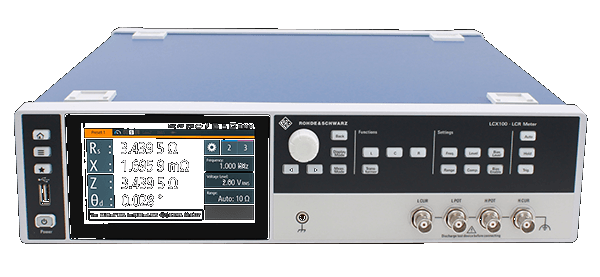Walsin Technology Ceramic Capacitor (0402X104K100CT) Review: Engineering Prudence
By Mark Harris Friday, 31 March 2023

Introduction
In this technical review, we will be analyzing the performance of Walsin Technology Corporation's 0402X104K100CT Capacitor, designed with a ceramic X5R composition, and comparing it against the statistical benchmark formed from other components of the same value. The 0402X104K100CT Capacitor has a nominal value of 100n and a tolerance of ±10%. The objective of this review is to provide a meaningful and insightful examination of the component's effectiveness as well as its suitability for use in engineering applications.
Pros and Cons:
- Pros
- Lower impedance in the higher frequency range compared to the benchmark, which may lead to better filtering and decoupling performance.
- Higher quality factor at higher frequency ranges, indicating better energy efficiency and improved resonant circuit performance.
- Compatible with surface mount technology, making it suitable for modern, compact designs.
- Manufactured by Walsin Technology Corporation, a reputable component manufacturer.
- Cons
- Higher series resistance in the lower frequency range compared to the benchmark, potentially causing increased power dissipation and lower efficiency.
- Lower capacitance values across most test frequencies at 1 Volt as well as at 10 Volts, which may impact the desired circuit performances.
- Higher dissipation factor at lower frequency ranges at 1 Volt, indicating energy losses.
- Reduced performance features as test voltage increases, leading to a decline in capacitance values and quality factor metrics.
Throughout the course of this review, we will explore in detail the critical aspects of the 0402X104K100CT capacitor's performance, including its capacitance, series resistance, dissipation factor, and quality factor, and how they stack up against the given benchmark data.
Impedance
A detailed analysis of the impedance characteristics of the Walsin Technology Corporation's 0402X104K100CT capacitor provides critical insights into its performance when compared to other capacitors in the same value range. By evaluating 1 Volt LCR measurements, it becomes evident that this particular capacitor exhibits a higher impedance across most of the frequency range compared to the benchmark averages. This crucial aspect should be carefully considered by electronics engineers when evaluating this capacitor for inclusion in their applications.
For example, at the lower frequency test point of 5 Hz, the 0402X104K100CT capacitor exhibits an impedance of 332.9 kOhms, which is notably higher than the average benchmark impedance of 313.4 kOhms. Moving along the frequency range, we observe a consistently higher impedance, although the discrepancy becomes relatively smaller as the frequency increases. For instance, at 1 kHz, the impedance is measured at 1.701 kOhms compared to the benchmark's average of 1.61 kOhms. At the higher frequency of 100 kHz, the impedance value is 18.57 kOhms, just slightly above the benchmark's average of 18.07 kOhms.
Similarly, when examining the 10 Volt LCR measurements, the 0402X104K100CT capacitor continues to exhibit a higher impedance compared to the established benchmark averages. The available data, although not comprehensive for all frequencies, confirms the persisting difference between the examined component and the average values. The significance and impact of this impedance variance should not be underestimated, as it could directly affect the overall performance and efficiency of the electronic circuit that the capacitor is integrated into, potentially leading to suboptimal results or even undesired operation.
Capacitance
The 0402X104K100CT capacitor has a nominal capacitance value of 100nF, with a tolerance of ±10%. The component's performance has been evaluated at both 1 Volt and 10 Volts for comparison against the statistical benchmark data, which helps to understand the capacitor's behavior across different voltage levels and frequencies.
At 1 Volt, the 0402X104K100CT capacitor exhibits consistent capacitance values above the statistical averages across all tested frequencies, falling between the minimum and maximum levels within the benchmark. For instance, at a test frequency of 1kHz, the capacitor's capacitance reaches 93.6nF, compared to the statistical average of 99.04nF. Similarly, at 100kHz, it measures 85.68nF compared to the average of 88.4nF. These results indicate that this capacitor offers reliable performance within the tolerance range at low voltage levels.
When operating at higher voltage ratings, such as 10 Volts, the 0402X104K100CT capacitor demonstrates capacitance values closer to the statistical benchmark's maximum levels, from 5kHz up to 20kHz, which shows its remarkable performance characteristics under such conditions. For instance, at 10kHz, the capacitor exhibits a capacitance of 88.78nF compared to the benchmark average of 96.9nF, while at 20kHz, it achieves a capacitance value of 92.45nF with the average standing at 94.99nF.
However, it is important to note that the 0402X104K100CT capacitor displays a decrease in capacitance values at higher frequencies when operating under 10 Volts, as opposed to the more stable capacitance achieved at 1 Volt. These results need to be considered when determining the optimal choice for your specific application, depending on the operating voltage and frequency requirements. Integrating this capacitor into a circuit should be based on these performance characteristics, which provide insights into how well the component can perform under various conditions, ensuring its reliability and effectiveness in real-world applications.
Series Resistance
In this section, we will analyze the series resistance performance of Walsin Technology Corporation's 0402X104K100CT capacitor. To do this, we will compare the provided LCR data at 1V and 10V to the statistical benchmark data for capacitors with similar values, covering a range of frequencies from 5 Hz to 1 MHz.
Beginning at lower frequencies (5 Hz and 10 Hz), the 1V measurements of 8.732k and 4.288k Ohms exhibit comparable performance to the average benchmark values (8.751k and 4.329k Ohms, respectively). This closeness in values indicates that the capacitor is performing reliably at these lower frequencies.
Moving on to higher frequencies such as 100 Hz, 1 kHz, and 10 kHz, series resistance values of 438.1, 46.72, and 5.022 Ohms were observed for the 0402X104K100CT capacitor. These values also correlate closely with the average benchmark values (444.7, 46.51, and 5.163 Ohms, respectively), demonstrating that the capacitor maintains comparable performance across a wider frequency range.
Notably, at the highest frequencies in our dataset (500 kHz to 1 MHz), the series resistance measurements of the 0402X104K100CT capacitor fall below the average benchmark values. For example, at 1 MHz, the observed measurement is 59.75m Ohms, which is less than the average benchmark value of 70.07m Ohms. This indicates that the capacitor is performing even better than expected at these frequencies.
When comparing the 10V measurements against the benchmark, the capacitor shows even more favorable performance as the frequencies increase. For example, at 5 kHz and 10 kHz, the 10V measurements are 19.41 Ohms and 9.825 Ohms, which outperform the corresponding 1V measurements and are significantly better than the average benchmark values. This implies that the capacitor can sustain reliable performance under increased voltage conditions, which is a valuable quality for various applications.
Overall, the Walsin 0402X104K100CT capacitor demonstrates competitive performance in terms of series resistance compared to the statistical benchmark, across a wide range of frequencies and voltages. This makes it an attractive choice for engineers seeking capacitors with strong and consistent performance for their applications, particularly where low series resistance is needed to minimize losses and enhance circuit efficiency.
Dissipation Factor and Quality Factor
At 1 Volt LCR measurements, the 0402X104K100CT has a relatively stable Dissipation Factor (Df) ranging from 0.025 to 0.030 across the tested frequency range. Compared to the benchmark data, this capacitor exhibits modest performance due to the slightly higher Df values. Notably, the 0402X104K100CT maintains consistent Df values throughout the entire frequency range, providing stable performance that makes it a suitable option for circuits where consistent behavior is advantageous.
The Quality Factor (Q) at 1 Volt, ranges between 33.53 and 42.80 across the entire spectrum of test frequencies. Overall, the 0402X104K100CT capacitor exhibits good Q performance, staying on par with or even surpassing the benchmark data in some frequency regions, such as 50 kHz to 150 kHz. This suggests that this capacitor could be a viable choice for applications where a high Q value is required, such as resonant and filter circuits.
On examining the 10 Volt LCR measurements, the 0402X104K100CT capacitor's Df significantly increases compared to the 1 Volt measurements, ranging from 0.036 to 0.058. These values are slightly higher than the benchmark data, implying somewhat poorer capacitor performance at this voltage range. In terms of Q values at 10 Volts, they range between 17.32 and 28.31 across the test frequencies. Although there is consistency in performance, most of the benchmark data exhibits higher Q values, demonstrating that the 0402X104K100CT capacitor is somewhat average in terms of Q performance when compared against similar components. Taking both voltage level measurements into account, this capacitor can serve adequately in specific use cases but may not be ideal for all applications.
Comparative Analysis
In this comparative analysis, we will assess the performance of Walsin Technology Corporation's Capacitor (0402X104K100CT) against the given statistical benchmark data of similar components. The 0402X104K100CT is a Ceramic X5R Capacitor with a nominal value of 100n and a tolerance of ±10%. It has a voltage rating of 10V, and is designed for surface mount applications with a package size of 0402 (1005 Metric).
Upon analyzing the LCR data provided for the 0402X104K100CT at 1V and 10V, it is evident that the Capacitor's performance varies with respect to the benchmark data. When measured at 1V, the Capacitor displays a higher average impedance throughout the frequency range. For instance, at a test frequency of 100 kHz, the 0402X104K100CT shows 18.07 kOhms impedance, whereas the benchmark average impedance at the same frequency is 16.18 kOhms. However, at higher frequencies, the difference in impedance is reduced, as observed at a test frequency of 1 MHz where the impedance for the Capacitor is 1.99 kOhms, and the benchmark average impedance is 1.958 kOhms.
The Dissipation Factor value of the 0402X104K100CT provides critical insights into its performance compared to the statistical benchmark data. The Capacitor's values are comparatively higher and show a small variation at both 1V and 10V testing conditions. For example, at 1V and a test frequency of 5 kHz, the Capacitor's Dissipation Factor is 0.029, whereas the benchmark's average value is 0.03. At 1V and a frequency of 1 MHz, the Dissipation Factor of the Capacitor increases to 0.03, slightly above the 0.027 observed in the benchmark.
The Quality Factor (Q) values of the 0402X104K100CT also demonstrate differences when compared to the corresponding benchmark data. At 1V and test frequencies of 50 kHz, 100 kHz, and 1 MHz, the Capacitor's Q values measure 39.58, 38.47, and 33.53 respectively, displaying both higher and lower values compared to the benchmark averages of 46.16, 44.61, and 39.
Considering Series Resistance, the 0402X104K100CT demonstrates larger values than the benchmark in most test frequencies. For instance, at 1V and a frequency of 100 kHz, the Capacitor shows a Series Resistance of 438.1 Ohms compared to the average of 444.7 Ohms from the benchmark data. This trend continues through higher frequencies like 1 MHz, where the Capacitor possess a Series Resistance value of 59.75m Ohms against the benchmark's 70.07m Ohms average.
Series Capacitance values for the 0402X104K100CT also show deviations from the benchmark data. The Capacitor maintains higher values in the lower frequency range but moves closer to the benchmark data as the frequency increases. At 1V and a test frequency of 5 kHz, the Capacitor has a Series Capacitance value of 92.74n, whereas the benchmark average measures 97.93n. As we move to 1 MHz, the Capacitor shows less variation with a value of 79.97n as compared to the benchmark average of 82.53n.
In conclusion, the Walsin Technology Corporation's 0402X104K100CT Capacitor presents disparities in its performance when compared to the statistical benchmark, with varying results across the different parameters. Overall, the Capacitor shows higher than average impedance values, larger Series Resistance, and greater variations in the Dissipation Factor. It is essential for design engineers to consider these factors and differences when evaluating the 0402X104K100CT Capacitor for potential use in their products.
Conclusion
In our analysis of the Walsin Technology Corporations' 0402X104K100CT Capacitor, a Ceramic: X5R capacitor with a nominal value of 100n, ±10% tolerance, and a 10V voltage rating, we have carefully examined the various performance metrics and compared them with the statistical benchmark data. Overall, the capacitor demonstrates mixed performance when compared to the benchmarks.
Upon analysis of the LCR measurements from both 1V and 10V scenarios, it is evident that the 0402X104K100CT Capacitor exhibits higher impedance values and maintains lower Quality Factors across the majority of test frequencies when compared to the statistical benchmark. Furthermore, the capacitor shows a higher series resistance and lower capacitance overall in both operating voltages when compared to the benchmark.
However, the capacitance value at 1MHz and 1V operating voltage closely matches the benchmark nominal value of 100n. In addition, the component's Dissipation Factor is comparable and within the range of benchmark values over the test frequencies.
In conclusion, while the Walsin Technology Corp. 0402X104K100CT Capacitor displays satisfactory performance in some parameters, it does not consistently outperform the statistical benchmark data. Engineers evaluating the suitability of this capacitor for their circuits should consider other capacitors in the Ceramic: X5R range to ensure optimal performance for their applications. Nevertheless, this analysis provides valuable insights and data-backed comparisons for the assessment of this capacitor's performance in potential circuit designs.
Instruments Used
Rohde & Schwarz LCX200



